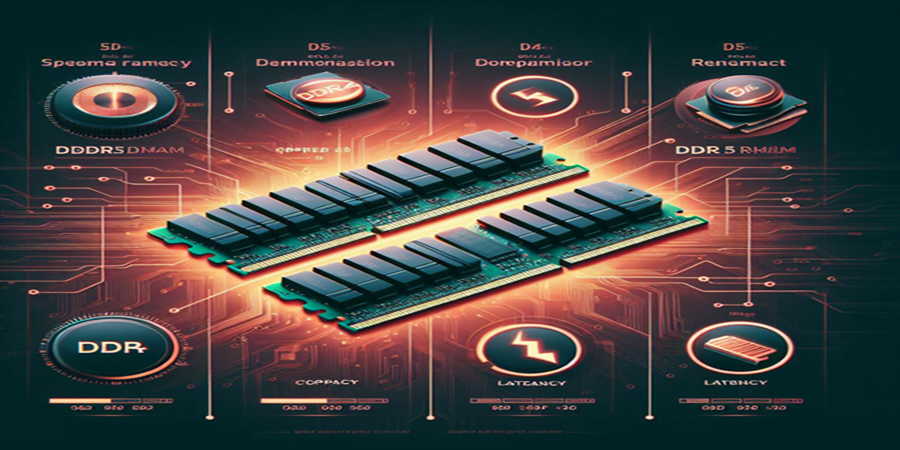What is the difference between ddr4 and ddr5? In the last article, we talk about Random Access Memory (RAM) as a crucial component within your computer system. This component is prevalent in most smart devices, extending its presence to your smartphone, home gaming console, and even various accessories and devices, so in this article, you will know the difference between them.

Table of Contents
Toggle1. Difference between ddr4 and ddr5
There are most 4 differences between ddr4 and ddr5 ram and they are as follows:
- The bandwidth or speed of the ram
- Power consumption of DDR5
- Channel Architecture in DDR5 RAM
- Difference between RAM capacity between DDR4 and DDR5
Now we will talk in detail about these points.
1. The bandwidth
One of the primary distinctions between these two types of Random Access Memory lies in the bandwidth, or let’s say the speed This term is a literal translation of the Bandwidth term you’ve undoubtedly encountered before if you’re interested in the realms of computers and hardware. Memory bandwidth is measured by the rate at which data moves between the processor, storage disk of any kind, and the memory itself in sequential operations, naturally. As you might guess, the higher the bandwidth in RAM, the faster and more efficiently it operates.
Currently prevalent DDR4 memories boast a bandwidth of up to 3.2 gigabits per second for each of their connectors, while DDR5 is set to arrive with nearly double this figure, approximately 6.4 gigabits per second.
Additionally, the new DDR5 RAM technology not only enhances bandwidth but also introduces a multiplied frequency. As we’re aware, our current DDR4 memories typically operate within an initial frequency range of 1600 to 3200 megahertz, with leading models reaching between 4000 and 5000 megahertz. In contrast, DDR5 memories will boast frequencies reaching up to 8400 megahertz, initially ranging from 3200 to 6400 megahertz but soaring to the massive 8400 megahertz mark in the pricier and more powerful variants you can visit Samsung website to know more about this new tech.
2. Power consumption of DDR5
Another significant distinction between these two types of RAM lies in power consumption. Here, we observe a substantial and notable advancement between DDR5 and DDR4. In DDR4 memories, power management was handled by the motherboard itself. However, DDR5 memories will delegate this task to a separate chip known as PMIC (Power Management Integrated Circuit).
This means that random access memories will operate more intelligently, drawing only the necessary power, no more and no less. Ultimately, this leads to adaptive power consumption tailored to your usage, rather than a fixed energy draw. In general, DDR5 memories will showcase a higher level of professionalism in terms of power and electricity management.
3. Channel architecture in DDR5 RAM
Here, we encounter another significant difference between the two generations. Perhaps you’ve come across terms like Dual Channel or Quad Channel before. These refer to the placement of your random access memories on the motherboard in a dual or quad configuration with a specific arrangement. This technique significantly contributes to performance enhancement, particularly with Ryzen chips. The technical foundation of this process lies in the distinct interconnection of memories in Dual Channel mode with the central processing unit, allowing it to access different sectors of data within the random access memories.

The revolutionary and intriguing aspect of DDR5 memories is that each chip is inherently dual-channel! This means that simply slotting in one chip on your motherboard seamlessly activates the Dual Channel feature. The more chips you add, the more channels you naturally get. The handling of this feature often varies among different tech manufacturers in the industry.
4. Difference between RAM capacity between DDR4 and DDR5
This marks the final significant difference between the two discussed RAM types the individual chip’s total capacity. Presently, DDR4 chips have a maximum capacity, accepting up to 16×16 gigabits, totaling 256 gigabits or 32 gigabytes. However, the landscape shifts with DDR5, where each chip can support up to 1024 gigabits, amounting to a staggering 128 gigabytes.
This implies that DDR5 memories can reach a capacity of 128 gigabytes per RAM module. This substantial figure, coupled with its ability to support Dual-Channel in a single memory module, suggests a future where acquiring a single 128-gigabyte RAM module with Dual-Channel support might become a reality.

FAQ

Q1 What is better DDR4 or DDR5?
The choice between DDR4 and DDR5 depends on your specific requirements and the technology compatibility of your system. DDR5 is the latest generation of RAM, offering higher data transfer rates, increased bandwidth, and improved power efficiency compared to DDR4. If you’re building a new system or upgrading existing hardware and your motherboard supports DDR5, it might be a preferable choice for better performance. However, if your system only supports DDR4, it remains a reliable and widely-used option with proven stability. Consider factors such as budget, system compatibility, and your performance needs when deciding between DDR4 and DDR5.
Q2 Does DDR5 make a difference?
Yes, DDR5 can make a noticeable difference in system performance compared to DDR4. DDR5 offers higher data transfer rates and increased memory bandwidth, resulting in improved overall system responsiveness, especially during resource-intensive tasks like gaming, content creation, and multitasking. Additionally, DDR5 is designed to be more power-efficient, potentially leading to better energy consumption management and longer battery life in laptops. Choosing DDR5 for a new system build may also provide better support for upcoming technologies, contributing to a more future-proofed setup. However, the actual impact on day-to-day tasks will depend on the specific use case and the rest of the system’s components. Consider your computing needs and system requirements when deciding whether DDR5 is the right choice for you.
Q3 Is 16GB DDR4 better than 8GB DDR5?
The comparison between 16GB DDR4 and 8GB DDR5 involves multiple factors. DDR5 generally offers higher data transfer rates and improved performance compared to DDR4. However, the amount of RAM (8GB or 16GB) is also crucial, depending on your specific usage.
If your computing needs involve demanding applications, gaming, or content creation, the larger 16GB capacity might provide smoother performance, especially for multitasking and handling large datasets. On the other hand, if your usage is less resource-intensive, and your system supports DDR5, the increased data transfer rates of DDR5 might compensate for the lower capacity in certain scenarios.
Consider the nature of your tasks, the requirements of the software you use, and the overall system specifications when deciding between 16GB DDR4 and 8GB DDR5. For optimal performance, it’s essential to strike a balance between both capacity and speed based on your individual needs.
Q4 Is it worth upgrading to DDR5?
Consider upgrading to DDR5 based on your performance needs and future-proofing goals. DDR5 offers higher data transfer rates, increased bandwidth, and improved power efficiency for tasks like gaming and content creation. Ensure system compatibility and that you don’t have any bottleneck effects, weigh the budget against perceived benefits, and assess current performance before deciding. Upgrading to DDR5 is worth considering for enhanced performance and future compatibility, but evaluate your specific requirements and budget constraints first.
Conclusion
In conclusion, the difference between DDR4 and DDR5 extends beyond just data transfer rates. While DDR5 sets the stage for the future of memory technology with its impressive performance, DDR4 remains a reliable and cost-effective option for many users. Assessing your specific needs and understanding the nuances of each technology will guide you in making the right choice for your computing requirements.
Finally, I hope my article added some valuable information to you. If you have some questions? Let me know in the comments below. I’ll try my best to answer them.




